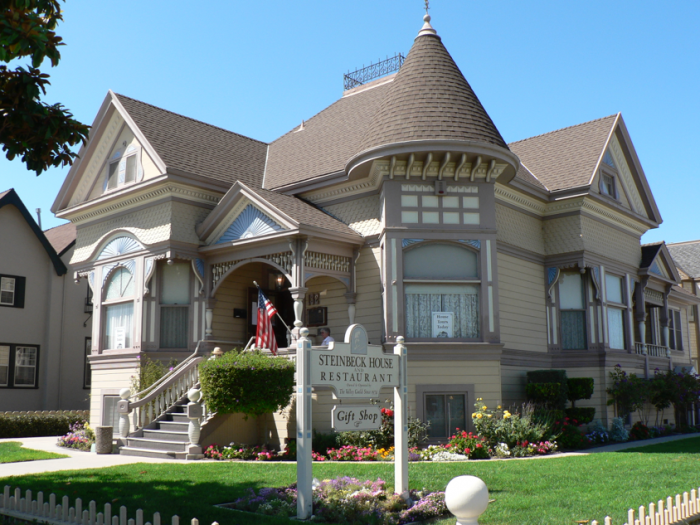Salinas in Monterey County – travel blog part ii
“Monterey County Part II” could also be called John Steinbeck Country. The places at issue are the agricultural communities of Salinas, Castroville and Watsonville as well as the town of Monterey. We’re into Grapes of Wrath and Cannery Row territory here.
If Part I was about artists and Hollywood stars finding this beautiful corner of the world, then Part II is about laborers drawn here for abundant farming and fishing.
Steinbeck (1902-1968) was born in Salinas in this charming Victorian:

132 Central Avenue – it’s a restaurant, not a museum, but if you come as a group, you can reserve a docent talk
The National Steinbeck Center is a couple of blocks away:

1 Main Street
Steinbeck is Salinas’s favorite son, of course, because he won the Nobel Prize for Literature in 1962. He is justly famous for bringing to life the conditions of farm laborers in the Salinas Valley, one of the largest and most productive agricultural areas in California.
The Grapes of Wrath (1939) chronicled the story of the Joad family who left the dust bowl conditions in Oklahoma during the Great Depression to come to this part of the world as pickers.

Cover artist Elmer Hader
You have likely seen this iconic photograph from the 1930s

Photographer Dorothea Lange’s ‘Migrant Mother’
The subject, Florence Owens Thompson, was 32 years old at the time and had 7 seven children. Although Steinbeck did not base The Grapes of Wrath directly on Thompson, her story was his for the telling. She has been much studied.
Still today Salinas Valley is an abundant source of produce. Roadside stands are everywhere, selling all kinds of fruits and vegetables.
We were particularly attracted to the Pezzini Farms store:

Inside are fantastic displays of produce, honey products, local baked items
Among many other things, we bought a particularly good Gizdich Ranch (Watsonville) very berry pie. It includes olallieberry, which I’d never heard of before:

Olallieberry shrub – looks like a blackberry but isn’t quite. The pie was wonderful
Outside is the Pezzini Choke Coach:

You can get ‘em French fried, steamed, grilled, what-have-you
Speaking of artichokes, Castroville is the self-proclaimed artichoke capital of the world:

The Castroville Artichoke Festival this year is June 3-4
Watsonville has a corner on strawberries:

The Watsonville Strawberry Festival this year is August 6 & 7
The beauty of the fields is such that photographers Cathy Hass and Mary Beth Bowman have made them subjects of their art:

Lines of abundance converging on the horizon
Finally, the area cannot be spoken of about without mention of Cesar Chavez (1927-1993), an American labor leader and civil rights activist who, with Dolores Huerta, co-founded the United Farm Workers Association in 1962.

Chavez, Monterey County in 1970
Then for us it was on to Moss Landing and Phil’s Fish Market:

Unless you get there early, you will wait in line
The thing to order is the cioppino:

A hearty seafood gumbo, as you see. I recommend splitting an order with another person. I could not do it justice
Phil’s has a bright and pleasant atmosphere:

Dining is casual
We saw Sea Otter Crossing signs:

Alas, we saw no sea otters. However, we did hear the sea lions barking
To come full circle, namely back to Carmel Valley (Monterey County Part I), I note that Earthbound Farm was the beginning of the organic movement in the U.S.
It’s first location was 2.5 acres on Carmel Valley Road and now has nearly 50,000 acres in production.

Drew and Myra Goodman began small in 1984 and sold to WhiteWave Foods in 2013 for $600 million
All this abundance comes at a price, of course, and can be measured in gallons of precious water.
Final note: After years of drought this winter finally brought California much-needed precipitation, rain at the lower levels, snow at the higher. The masses of the snow in the Sierra Nevada is certainly good news, but California is not out of the woods yet.
I hope to entice you to read the following article by repeating the question that opens it:
Which consumes the most water:
- a 10-minute shower
- a handful of 10 almonds
- a quarter-pound hamburger
- a washing machine load
You’ll find the answer here.
Categorised in: Adventure, North America
This post was written by Julie Tetel Andresen
You may also like these stories:
- google+
- comment



